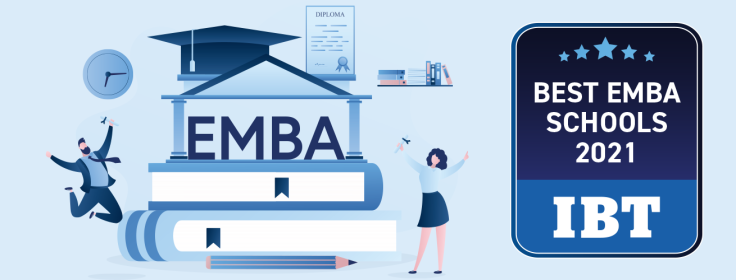As businesses look forward with hope and finally see opportunity after the challenges of 2020, International Business Times has partnered with Ken Research to rank the best international Executive MBA programs offered by U.S. schools. Our ranking of U.S. EMBA programs, which will become an annual feature, is part of our commitment to bring to our readers the information and data necessary for them to make informed choices.
IBT's list of U.S. B-schools offering EMBA programs reflect the values we believe will be integral for business leaders to succeed in a new globalized economy; a world-market where some of the accepted values and mores are being uprooted and replaced by those centered on inclusivity, respect and sustainability. But it also goes above and beyond that.
U.S. colleges command global recognition and the number of international students opting for an EMBA in the country has grown over the years. This diversity offers a great opportunity for future business leaders — to familiarize themselves with diverse cultures and values as they hope to expand and do business across geographies and cultures.
Schools have recognized this need and are trying to attract professionals from different ethnic groups and different industry/market experiences.
IBT's ranking gives due consideration to this diversity — because it is not just about equal opportunities and respect, but also a key requirement driven by the needs of equitable growth and bottom-up management.
A similar story is playing out on the gender diversity front. The Executive MBA Council's research shows that female enrolment in EMBA programs in 2020 reached 32%, at its highest ever, from 29.7% in 2016. That means, close to one in three new enrolments in EMBA programs is a woman. Those numbers alone indicate the importance of gender diversity in ranking business schools.
But the pandemic-induced disruptions have also stressed the many fault lines in the world of business and politics, and there is growing impatience at some of the inequities that have persisted over the decades. Schools that encourage gender diversity are not just tipping their hat at this movement that is gathering steam but also building huge social capital, as they contribute to shatter the proverbial glass ceiling.
A list like this has to be firmly rooted in reality, and has to pass the all-important test of real-world value.
The Executive MBA Council's (EMBAC) exit survey showed that EMBAs saw a 14.1% increase in compensation – including salary and bonuses – after graduation, with an average median salary and bonus package totaling $193,200. Almost 40% of students reported receiving a promotion during their EMBA program.
Students invest considerable money and time into these programs. Nearly 120 universities and colleges offer EMBA programs in the U.S., at an average fee of $110,00; and 74 offer Global EMBA programs at an average fee of $125,000. A Global EMBA program is more tailored toward giving global exposure in terms of work environment, work culture, global work ethics and includes travel to various countries to understand the business environment.
A majority of professionals opting for an EMBA belong to the IT, healthcare, financial services and consulting industries, followed by construction, manufacturing and others.
Even as we acknowledge the unfolding trends and the zeitgeist in our rankings, we also ensure that this value proposition is captured adequately – by looking at the popularity of schools among the people who matter the most: its consumers — the students. This we do through two key metrics: Enrollments, which show how popular schools are with students, and college revenue, which is a proxy for the real world value that a program offers its students.
IBT's EMBA rankings are both a nod to a more equitable and sustainable future and also a touch stone of real value.
If your school is listed, please contact us by clicking here to find out more about licensing and other options.
Notes On The Ranking
- The rankings are from 1 to 70, with 1 being the highest rank.
- Overall scores for the schools were calculated by assigning weightage for each of the parameters considered, depending on their importance from a potential student's perspective. A lower score denotes a higher rank.
- College revenue: Total revenue and course duration were taken as one of the indicators to determine the ranking. This indicator has a 15% weightage in the overall rating.
- Flexibility: Indicates the availability of a course customization option. (Key to reading the score: 1 - customization available for the program; 2 – no customization option.) Has a 10% weightage.
- Enrollments: The total student enrollments in a program; has a 20% weightage.
- Gender diversity: Ranks the program based on the ratio of male-to-female students; has a 15% weightage.
- Online availability: Indicates whether the program can be taken online partly. (Key: a score of 1 indicates that two-thirds of the program can be taken online; 2 indicats that a third of the program can be taken online; 3 indicates the online option is not available.) This parameter has been given a 10% weightage.
- Cultural diversity: Ranks the program based on the ratio of international students to domestic students; has a 15% weightage.
- Industry diversity: Measures the diversity of industries represented in a class; has a 15% weightage.
Research Methodology
- A full list of all the colleges and universities offering EMBA programs was created through analysis of existing industry factors, college program brochures obtained from college reports, in addition to magazines, journals and online articles.
- Computer-assisted telephonic interviews were conducted with the administration and admission staff of these universities and colleges to evaluate their operational indicators. These were further validated by posing as a potential candidate.
- The EMBA performing index was created by evaluating the total ratings on the basis of the following parameters: college revenue, student diversity, enrollments and course customization, among others. Each of these parameters was accorded weightage based up on the selection criteria that a typical potential student would use while evaluating a school.


